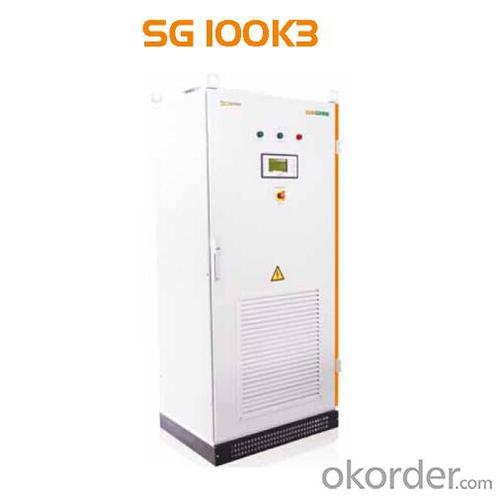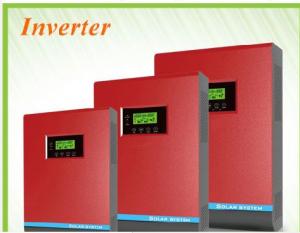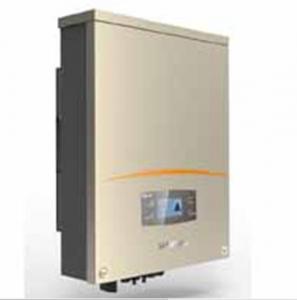12 Volt MPPT Solar Inverter Photovoltaic Grid-Connected Inverter SG100K3
- Loading Port:
- China Main Port
- Payment Terms:
- TT or LC
- Min Order Qty:
- 30 unit
- Supply Capability:
- 1000 unit/month
OKorder Service Pledge
OKorder Financial Service
You Might Also Like
1. Structure of Photovoltaic Grid-Connected Inverter SG100K3 Description
A solar inverter, or PV inverter, or Solar converter, converts the variable direct current (DC) output of a photovoltaic (PV) solar panel into
autility frequency alternating current (AC) that can be fed into a commercial electrical grid or used by a local, off-grid electrical network.
It is acritical BOS–component in a photovoltaic system, allowing the use of ordinary AC-powered equipment. Solar inverters have
special functions adapted for use with photovoltaic arrays, including maximum power point tracking and anti-islanding protection.
Suitable for 50Hz/60Hz grid, could be used in Asia, Australia and Europe.
2. Main Features of the Photovoltaic Grid-Connected Inverter SG100K3
* Advanced Technology, Grid-friendly
• Optional low-voltage and zero-voltage ride through to cope with various grid conditions
• SVG function at night, response to grid directives around the clock
• Reactive power control with power factor from 0.9 lagging to 0.9 leading
* More Compact, Saving Space for PV Plant
• Power density enhanced 40%, one of the central inverters with highest power density in the PV industry
• Save installation spaces and lower the plant initial cost
• Front maintenance, able to install against the wall, convenient installation and maintenance, saving operation cost of the PV plant
* Efficient, More Yields
• Max. efficiency at 97.3% with transformer
• Efficient MPPT control strategy, improve power yields
• 28335 chips adopted, more accurate calculation, more power yields
* More Advantages
• Perfect protection and fault alarm system, safe and reliable
• User-friendly dynamic graphics LCD
• Efficient PWM algorithm, low consumption of switch
• Operate without power derating at -25℃ - +55℃
• Reliable and continues operation in high altitude environment
• Auxiliary heater (opt.)
• CGC certification, compliance with BDEW
3. Photovoltaic Grid-Connected Inverter SG100K3 Images



4. Photovoltaic Grid-Connected Inverter SG100K3 Specification
Input Side Data |
|
Max. PV input power | 113KW |
Max. PV input voltage | 1000V |
Set-up voltage | 500V |
Min. operation voltage | 480V |
Max. PV input current | 236A |
MPP voltage range | 480~850V |
No. of DC inputs | 4 |
Output Side Data |
|
Nominal AC output power | 100KW |
Max. AC output apparent power | 110KVA |
Max. AC output current | 158A |
THD | <3%(Nominal power) |
Nominal AC voltage | 400V |
AC voltage range | 310V~450V |
Nominal grid frequency | 50/60Hz |
Grid frequency range | 47~52Hz/57~62Hz |
Power factor | >0.99@default value at nominal power, adj. 0.9 overexcited ~0.9 underexcited |
Isolated transformer | Yes |
DC current injection | <0.5 % In |
Efficiency |
|
Max. efficiency | 97.30% |
European efficiency | 96.70% |
Protection |
|
Input side disconnection device | Breaker |
Output side disconnection device | Breaker |
DC overvoltage protection | Yes |
AC overvoltage protection | Yes |
Grid monitoring | Yes |
Ground fault monitoring | Yes |
Insulation monitoring | Yes |
General Data |
|
Dimensions(W×H×D) | 806×1884×636mm |
Weight | 760kg |
Operating ambient temperature range | -25~+55℃ |
Night power consumption | <40W |
External auxiliary supply voltage | No |
Cooling method | Temperature controlled air-cooling |
Ingress protection rating | IP21 |
Allowable relative humidity range | 0~95% no condensing |
Max. operating altitude | 6000m(>3000m derating) |
Fresh air consumption | 870m³/h |
Display | LCD |
Communication | RS485/Modbus, Ethernet(Opt.) |
5. FAQ of Photovoltaic Grid-Connected Inverter SG100K3
Q1. What is the difference between inverter and solar inverter?
A1. Inverter only has AC inpput, but solar inverter both connect to AC input and solar panel, it saves more power.
Q2. What is the difference between MPPT&PWM?
A2. MPPT has higher efficiency, it can track the max power point and won't waste energy.
- Q: Can a solar inverter be used in a ground-mounted solar tracking system?
- Yes, a solar inverter can be used in a ground-mounted solar tracking system. In fact, the solar inverter is an essential component of the system as it converts the DC electricity generated by the solar panels into AC electricity that can be used to power appliances and be fed into the grid. The solar inverter's functionality remains the same whether it is used in a ground-mounted solar tracking system or a fixed tilt system.
- Q: Can a solar inverter be used with battery storage?
- Yes, a solar inverter can be used with battery storage. In fact, integrating a solar inverter with battery storage systems allows for storing excess solar energy generated during the day and using it at night or during times of high energy demand. This combination enables greater energy independence and the ability to use renewable energy even when the sun is not shining.
- Q: Can a solar inverter be used in harsh environmental conditions?
- Yes, solar inverters are designed to withstand harsh environmental conditions such as extreme temperatures, high humidity, and exposure to dust, dirt, and corrosive elements. They are built with robust materials and undergo rigorous testing to ensure their durability and reliability in challenging environments. Additionally, some solar inverters come with IP65 or higher ratings, indicating their resistance to water and dust ingress, making them suitable for installation in outdoor and harsh conditions.
- Q: How does a solar inverter handle voltage dips or fluctuations in the grid?
- A solar inverter handles voltage dips or fluctuations in the grid by constantly monitoring the grid voltage. When it detects a dip or fluctuation, it adjusts its own output voltage accordingly to maintain a stable and consistent power supply. This helps protect connected devices from potential damage and ensures that the solar system continues to operate efficiently.
- Q: Can a solar inverter be used with bifacial solar panels?
- Yes, a solar inverter can be used with bifacial solar panels. Bifacial solar panels can generate electricity from both sides, capturing sunlight from both the front and back surfaces. The solar inverter is responsible for converting the DC power generated by the solar panels into AC power that can be used in homes or fed into the grid. Therefore, a solar inverter is an essential component for any solar panel system, including those with bifacial panels.
- Q: What are the communication protocols used in solar inverters?
- Solar inverters commonly use several communication protocols to enable communication with other devices or systems. Some of the most frequently employed communication protocols in solar inverters include: 1. Modbus: Modbus is an extensively utilized communication protocol for industrial devices, including solar inverters. It facilitates the transmission of data between the inverter and other devices, such as monitoring systems or data loggers. Modbus is well-regarded for its simplicity and flexibility, which contribute to its popularity in the solar industry. 2. SunSpec: SunSpec is a communication protocol specifically designed for the solar industry. It establishes a standardized means for solar inverters to communicate with other devices, such as smart meters or monitoring systems. SunSpec supports both wired and wireless communication, allowing for effortless integration of solar inverters into larger energy management systems. 3. CAN bus: CAN (Controller Area Network) bus is a widely employed communication protocol in various industries, including automotive and industrial applications. It is a robust and reliable protocol that enables high-speed communication between devices. Some solar inverters employ CAN bus to communicate with other devices or systems, ensuring a dependable means of data transfer. 4. Ethernet: Ethernet is a prevalent communication protocol in the IT industry and is also utilized in certain solar inverters. By utilizing Ethernet, solar inverters can communicate with other devices or systems over a local area network (LAN) or the internet. Ethernet offers high-speed communication and can accommodate various communication standards, making it a versatile option for solar inverters. It is essential to note that different solar inverter manufacturers may employ different communication protocols or a combination thereof. The selection of a communication protocol depends on factors such as the specific requirements of the system, compatibility with other devices or systems, and the desired level of integration.
- Q: How do you calculate the maximum power point tracking efficiency for a solar inverter?
- To calculate the maximum power point tracking (MPPT) efficiency for a solar inverter, you need to compare the actual power output of the inverter to the maximum power available from the solar panels. The formula for MPPT efficiency is: MPPT Efficiency = (Actual Power Output / Maximum Power Output) * 100 The actual power output is the power being delivered by the inverter to the load, which can be measured using a power meter. The maximum power output is the highest power that can be generated by the solar panels, which can be determined by conducting a performance test or referring to the manufacturer's specifications. By dividing the actual power output by the maximum power output and multiplying the result by 100, you can calculate the MPPT efficiency as a percentage. This efficiency metric helps evaluate how effectively the inverter is tracking the maximum power point of the solar panels, ensuring optimal energy conversion and utilization.
- Q: Can a solar inverter be used with a solar-powered CCTV system?
- Yes, a solar inverter can be used with a solar-powered CCTV system. A solar inverter is responsible for converting the direct current (DC) generated by the solar panels into alternating current (AC) that can be used to power the CCTV system. By connecting the solar panels to a solar inverter, the energy produced by the sun can be harnessed and efficiently utilized by the CCTV system.
- Q: How does a solar inverter handle power quality issues in the grid?
- A solar inverter handles power quality issues in the grid by continuously monitoring the electricity it receives from the grid. If it detects any power quality issues such as voltage fluctuations, harmonics, or frequency variations, it employs various techniques to mitigate these issues. These techniques include voltage regulation, reactive power compensation, filtering, and synchronization with the grid. By actively managing these power quality issues, a solar inverter ensures that the electricity it feeds into the grid is of high quality and complies with the grid's standards and requirements.
- Q: What is the role of a solar inverter in anti-islanding protection?
- The role of a solar inverter in anti-islanding protection is to detect when there is a loss of utility power and to disconnect the solar system from the grid. This is important to prevent the system from continuing to generate power during a power outage, which could pose a safety risk to utility workers who may be working on the grid. The solar inverter ensures that the solar system is synchronized with the grid and only operates when there is a stable utility power supply, thus providing a reliable and safe connection to the grid.
Send your message to us
12 Volt MPPT Solar Inverter Photovoltaic Grid-Connected Inverter SG100K3
- Loading Port:
- China Main Port
- Payment Terms:
- TT or LC
- Min Order Qty:
- 30 unit
- Supply Capability:
- 1000 unit/month
OKorder Service Pledge
OKorder Financial Service
Similar products
Hot products
Hot Searches
Related keywords


























